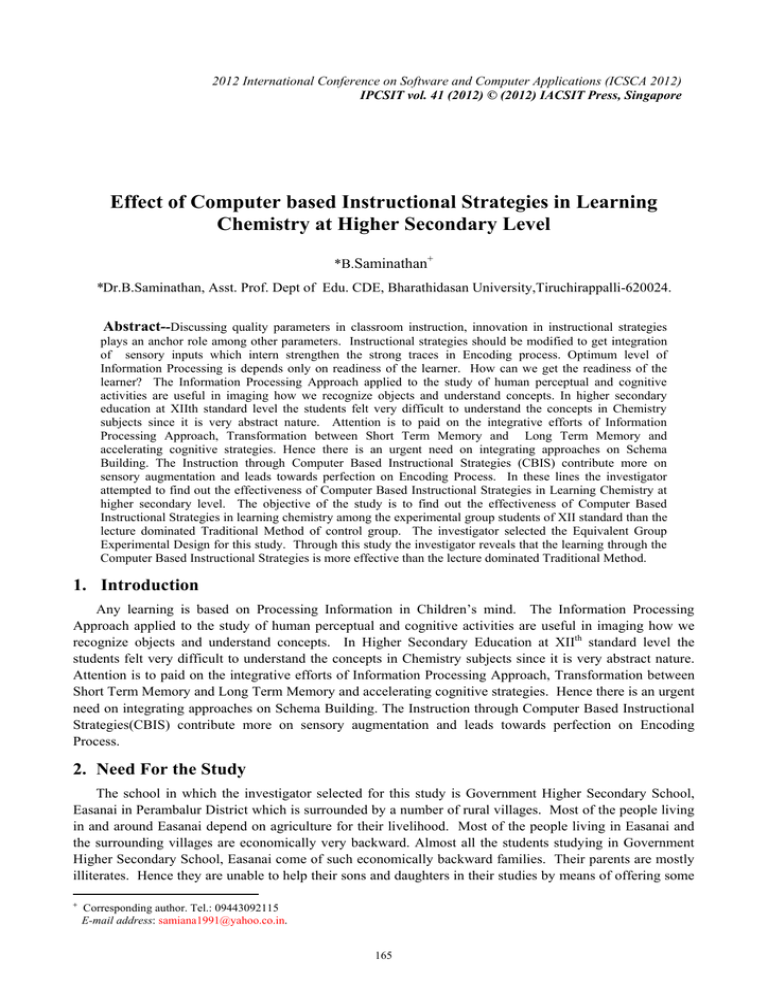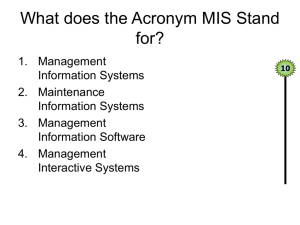Effect of Computer based Instructional Strategies in Learning Saminathan -
advertisement

2012 International Conference on Software and Computer Applications (ICSCA 2012) IPCSIT vol. 41 (2012) © (2012) IACSIT Press, Singapore Effect of Computer based Instructional Strategies in Learning Chemistry at Higher Secondary Level + *B.Saminathan *Dr.B.Saminathan, Asst. Prof. Dept of Edu. CDE, Bharathidasan University,Tiruchirappalli-620024. Abstract--Discussing quality parameters in classroom instruction, innovation in instructional strategies plays an anchor role among other parameters. Instructional strategies should be modified to get integration of sensory inputs which intern strengthen the strong traces in Encoding process. Optimum level of Information Processing is depends only on readiness of the learner. How can we get the readiness of the learner? The Information Processing Approach applied to the study of human perceptual and cognitive activities are useful in imaging how we recognize objects and understand concepts. In higher secondary education at XIIth standard level the students felt very difficult to understand the concepts in Chemistry subjects since it is very abstract nature. Attention is to paid on the integrative efforts of Information Processing Approach, Transformation between Short Term Memory and Long Term Memory and accelerating cognitive strategies. Hence there is an urgent need on integrating approaches on Schema Building. The Instruction through Computer Based Instructional Strategies (CBIS) contribute more on sensory augmentation and leads towards perfection on Encoding Process. In these lines the investigator attempted to find out the effectiveness of Computer Based Instructional Strategies in Learning Chemistry at higher secondary level. The objective of the study is to find out the effectiveness of Computer Based Instructional Strategies in learning chemistry among the experimental group students of XII standard than the lecture dominated Traditional Method of control group. The investigator selected the Equivalent Group Experimental Design for this study. Through this study the investigator reveals that the learning through the Computer Based Instructional Strategies is more effective than the lecture dominated Traditional Method. 1. Introduction Any learning is based on Processing Information in Children’s mind. The Information Processing Approach applied to the study of human perceptual and cognitive activities are useful in imaging how we recognize objects and understand concepts. In Higher Secondary Education at XIIth standard level the students felt very difficult to understand the concepts in Chemistry subjects since it is very abstract nature. Attention is to paid on the integrative efforts of Information Processing Approach, Transformation between Short Term Memory and Long Term Memory and accelerating cognitive strategies. Hence there is an urgent need on integrating approaches on Schema Building. The Instruction through Computer Based Instructional Strategies(CBIS) contribute more on sensory augmentation and leads towards perfection on Encoding Process. 2. Need For the Study The school in which the investigator selected for this study is Government Higher Secondary School, Easanai in Perambalur District which is surrounded by a number of rural villages. Most of the people living in and around Easanai depend on agriculture for their livelihood. Most of the people living in Easanai and the surrounding villages are economically very backward. Almost all the students studying in Government Higher Secondary School, Easanai come of such economically backward families. Their parents are mostly illiterates. Hence they are unable to help their sons and daughters in their studies by means of offering some + Corresponding author. Tel.: 09443092115 E-mail address: samiana1991@yahoo.co.in. 165 extra coaching at home. The students have to solely depend on their teachers at school for their studies. Therefore the teachers have a greater responsibility in making their students to learn thoroughly at school itself. Students felt very difficult to learn XIIth standard chemistry subject. Because the abstract content matters are make boring the learners and to induce disinterest. Abstract learning needs more sensory integration to fix up in the Long Term Memory.Therefore the investigator found himself under the compulsion of adopting a new technique of teaching that will be appealing to all the students with diverse intelligence. The memory strategies are used to enhance the processing. The use of Computer Based Instructional Strategies produces more integrated sensory output in learning Chemistry subjects. Audio Visual cues are augmented their sensory integration. 3. Computer Based Instructional Strategies (Cbis) Computer Based Instructional Strategies are applied to a teaching learning situation that involves the direct instructional interaction between computer and student. In this approach, the teacher, ultimately having responsibility for all instruction in the classroom, sets up the learning environment through careful selection and analysis of the instructional material, ensures that each student has the necessary entry-level knowledge, skills and attitude to engage in a particular activity monitors the learning activities, adjusting them according to the students needs and follows up with activities designed to promote retention and transfer of learning. In view of the above cognitive perspectives towards sensitize the students to get optimum level of processing information during direct learning, a computer based instructional strategies has been developed by assisting power point presentation in Tamil medium, is an added advantage to the students to understand easily and in turn it helps to concretizes the learning. 4. Impact Of Cbis Here audio and visual media induces sense organs to receive the stimuli and gather impressions in a selective way, filtering out much information and allowing only some environmental stimuli to enter the human processing system. The information can be held for a very brief time in the sensory channels themselves. This storage function of the sensory channels is called ‘Sensory Register’. Most of the information briefly held in Sensory Register is lost. What has been stored briefly simply decays from the Register. However when we use the CBL lessons for our instruction the information has got motivated and encoded in the sensory register. All stimuli that strike the particular sense organ within a range of receptiveness stored to their relative sensory stores. During this momentary retention, an interchange occurs its Long Term Memory. Here the retentivity of the sensory memory is enhanced by CBL lessons. OBJECTIVES OF THE STUDY The following are the objectives framed for this study 1.To develop CBIS for teaching chemistry at higher secondary level. 2.To apply CBIS for teaching chemistry at higher secondary level. 3.To find out the effectiveness of CBIS on learning chemistry at higher secondary level. RESEARCH HYPOTHESES The following are the hypotheses framed for this study. 1. There is no significant difference between the control group and the experimental group students in their mean scores of achievement in chemistry in the pre test. 2. There is no significant difference between the control group and the experimental group students in their mean scores of achievement in chemistry in the post test. 3. There is no significant mean difference between the pre test and post test scores of achievement in experimental group. 4. There is no significant mean difference between the pre test and post test scores of achievement in control group. 166 SAMPLE FOR THE STUDY The investigator has conducted the experiment in the classroom. XII Standard students of GHSS, Easanai, which is located in Perambalur District were selected for this study. All the 23 students of Mathematics background science group who are studying chemistry as one of the subjects were formed as control group. And all the 24 students of pure science group who are studying chemistry as one of the subjects were formed as experimental group. 5. Experimental Design In view of the nature of the problem, the investigator decided to employ equivalent group experimental design for this study. The experimental method involves the use of two groups for this study. One group is called the control group and the other group is considered to be the experimental group. While effecting these two groups the investigator should see to it that the subjects included in the two groups are equal in all significant aspects, especially in respect of age, sex, class achievements etc. In accordance with the above mentioned basic requirements of the experimental method, the investigator resolved on having two groups of students for this study. Fortunately they are almost equal in their performance in chemistry quarterly marks i.e., control group (43.7%) and experimental group (43.1%). All the 23 students of control group and 24 students of experimental group are equal in all respects. 6. Experimentation Phase I: Identifying the hardspots in XII th standard Chemistry. Phase II: Preparing the Computer Based Instructional Strategies for the hardspots by using Power Point in Tamil Medium. PhaseIII: Conducting pre test to maintain the equality of the two groups. PhaseIV: Conducting classes for experimental group students for four weeks by using Computer Based Instructional Strategies. Phase V: Administering post test to find out the impact of the Computer Based Instructional Strategies. Phase VI: Collecting the data and analyse to find out the impact. In this study the Computer Based Instructional Strategies were taught towards improve the learning abilities on hardspots. The students studying in XII th Standard, 47 students were selected as sample from Govt. Hr Sec School, Easanai, Perambalur District. A Pre-test was conducted to all the 47 students. Computer Based Instructional Strategies were taught by the class teacher for a period of four weeks. At the end of the sessions a post test was conducted. In addition to that progressive tests were conducted at every week end. The collected data were analysed. 7. Scheme of Analysis The pre test, Progressive Test I, II, III and Post test scores of both the control group and experimental groups were tabulated. First the mean and S.D for the pretest scores of the control group and experimental group were tabulated and analyzed descriptively. In order to compare and find out the difference between the achievement level of control and experimental group in the pre and post tests the investigator calculated 't' value for small samples. The values of Mean, S.D and 't' were tabulated and analyzed. TABLE-1 Comparison of mean, S.D and ‘t’ Scores of all the tests of the Control and Experimental groups. S. No 1 Test Pre-test Control Group Experimental Group ‘t’ Remarks M1=58.2 M2=57.17 0.69 NS S.D=4.75 S.D=5.48 167 2 Progressive1 3 Progressive2 4 Progressive3 5 Post-Test M1=58.40 M2=64.23 S.D=5.33 S.D=4.12 M1=58.88 M2=67.11 S.D=5.48 S.D=4.13 M1=60.62 M2=71.54 S.D=4.95 S.D=5.08 M1=60.64 M2=77.09 S.D=4.92 S.D=5.65 4.45 S 6.04 S 7.71 S 11.04 S 1) The mean scores of the control group in pre-test, progressive tests I, II, III, IV and post test were found to be 58.2, 58.4, 58.88, 60.62, and 60.64 respectively. The performance of the control group students was no change. 2) The mean scores of the experimental group in pre-test, progressive tests I, II, III, IV and post test were found to be 57.17, 64.23, 67.11, 71.54, 77.09 respectively. The experimental group students were found to have continuous gradual increase in their performance. 3) There is no significant difference between the control group and the experimental group students performance in the pre test. 4) There is significant difference between the control group and the experimental group students performance in the Progressive test I, II, III, IV & the post test. TABLE-2 Comparison of mean and S.D Scores of Pre test and Post test of the Control and Experimental groups S.NO 1 2 1) 2) Students Control group Pre test Post test ‘t’ Remarks M1=58.2 M2=60.64 0.338 NS S.D=4.75 S.D=4.92 Experimental group M1=57.17 M2=77.09 12.68 S S.D=5.48 S.D=5.65 There is no significant mean difference between the pre test and post test scores of the control group. There is significant mean difference between the pre test and post test scores of the experimental group. 8. Summary of Findings The major findings of the study were: 1) There is significant mean difference between the pre test and post test scores of the experimental group. So it indicates that teaching through CBIS techniques improves student achievement in chemistry. 2) The mean scores of the control group are not significantly differed in the post test than in the pre test 3) There is no significant difference between the control group and the experimental group in the pre test. 4) There is significant difference between the control group and the experimental group students in the Progressive test I, II, III & the post test. 5) There is significant mean difference between the post test scores of the control group and experimental group. So the treatment is considered to be effective. . 6) In teaching chemistry at Hr. Sec. Level CBIS proved to be an effective teaching strategy in all the progressive tests than the traditional method of teaching chemistry. 168 9. Educatonal Implication This study reveals that if the student's ability to CBIS is increased, they will show marked improvement in their achievement in the public examination result. Through this valuable study the investigator has established the fact that if the students are taught chemistry with the help of CBIS, they will be able to understand chemistry very easily. 1) The strategies of CBIS were found to be highly beneficial to make the students to understand the subject very easily. 2) The CBIS strategies helped the students memorize facts quite easily. 3) Through this study it is proved that Chemistry can be taught effectively and interestingly through the CBIS. 4) The CBIS strategies were found to be serving the purpose of reinforcement also. To sum up it may be rightly pointed out that the CBIS strategy can be effectively utilized by the teachers of Chemistry in order to increase the achievement of the students in the public examination. 10. Conclusion In a nutshell CBIS is found to be having effective on the achievement of learners because of the unwieldy strength in the class room, it is difficult to individualize the students. The proper training should be given to the teachers in CBIS to have effective influence in the learning process. From all direction it is viewed that CBIS can be the most effective strategy in learning chemistry at higher secondary level. 11. Reference [1] Allen, R.J. "A computer aided system for student education in technology",1997. [2] Englewood cliffs, N.J."Usage of Computers", Educational Technology Publications, USA, 1995. [3] Gurd, J.R. "A computer aided system for student education in technology", 1997 [4] Hmmel D.G. "Computer Assisted Instructions", Raytheon Company Bedford Mass, USA, 1993. [5] Lewis R., Tagg ED (Eds), Trends in computer assisted education, London, Blackwell scientific Publications,1987. [6] Shanmugasundaram and Stella, Effectiveness of CAI on learning English Grammar, Journal of Educational research and extension, October 1990 27(2) Pp.127-130. [7] Vazques Charles Lowis "The effectiveness of CAI on chemistry courses". Dissertation Abstract International, 1983. Vol.44, P.2673-A. [8] William J. Bramble, Emanuel J Manson, Paul Berg, Computers in school, New York, Mc Graw Hill Book Company, 1993. [9] Karter Kaywin "Evaluation of computer assisted metric instruction in a 9th grade physical science program", Dissertation abstract International, 1980. Vol.41, P4677-A. WEBSITES 1. http://www.nwrel.org/sepd/sirs/s/cu10.html 2. http://en.wikipedia.org 169




